The Scintillation Vials Market is estimated to be valued at USD 324.5 million in 2025 and is projected to reach USD 528.6 million by 2035, registering a compound annual growth rate (CAGR) of 5.0% over the forecast period.
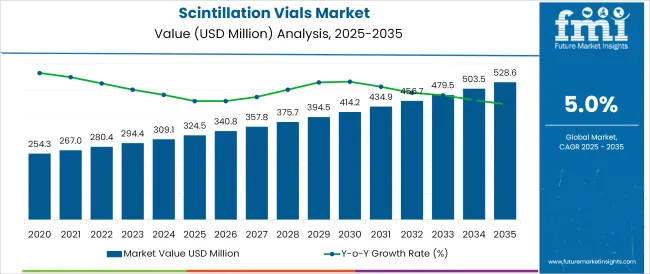
The scintillation vials market is advancing steadily, fueled by increased use of radioactive sample analysis in pharmaceutical R&D, environmental testing, and clinical diagnostics. Laboratories are prioritizing container integrity, optical clarity, and chemical resistance to enhance counting efficiency and minimize contamination risks.
Regulatory requirements for accurate radiation measurement, particularly in toxicology and isotopic studies, are pushing demand for standardized, leak-proof vials that support safety and analytical accuracy. Technological improvements in plastic molding and anti-static coatings have made newer vials more user-friendly and consistent in measurement output.
Additionally, the rise of automated liquid scintillation counters has necessitated greater compatibility between vials and equipment systems. Future market expansion is likely to be supported by increased global investments in nuclear medicine and life sciences research, with an emphasis on high-throughput workflows and safe sample handling practices.
The market is segmented by Material Type, Capacity Range, Application, and End Use and region. By Material Type, the market is divided into Plastic, Polyethylene (PE), High Density Polyethylene (HDPE), Low Density Polyethylene (LDPE), Polyethylene terephthalate (PET), Polypropylene (PP), and Glass. In terms of Capacity Range, the market is classified into 6 ml - 10 ml, Less than 5 ml, 11 ml - 20 ml, and 21 ml & Above.
Based on Application, the market is segmented into Scintillation Counting, Gamma Counting, Chromatography, Sample Storage, Cell Culturing, and Others. By End Use, the market is divided into Pharmaceutical & Biopharma, Forensics and R&D, and Veterinary.
Regionally, the market is classified into North America, Latin America, Western Europe, Eastern Europe, Balkan & Baltic Countries, Russia & Belarus, Central Asia, East Asia, South Asia & Pacific, and the Middle East & Africa.
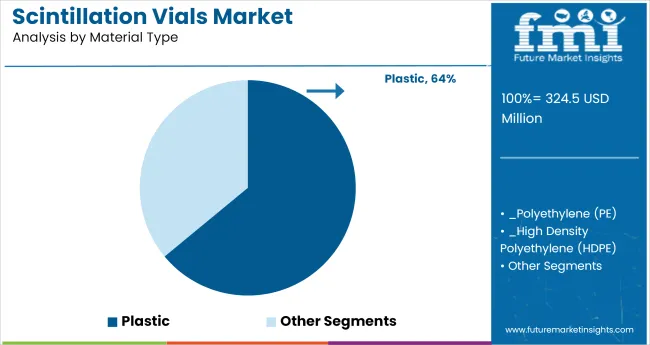
Plastic scintillation vials are expected to hold a leading 64.0% revenue share in the market in 2025. Their dominance is being driven by superior durability, reduced breakage risk, and chemical resistance, making them highly preferred for both manual and automated laboratory workflows. Plastic vials are significantly lighter than glass alternatives, contributing to easier handling and reduced shipping costs, especially in bulk laboratory settings.
Additionally, advancements in polymer chemistry have enhanced their transparency and resistance to aggressive solvents used in scintillation cocktails. Their compatibility with robotic sample handlers and low static charge properties make them ideal for precision counting applications.
Growing adoption of disposable, contamination-free lab practices further supports this segment, as plastic vials offer consistent performance with reduced sample interaction and improved safety.
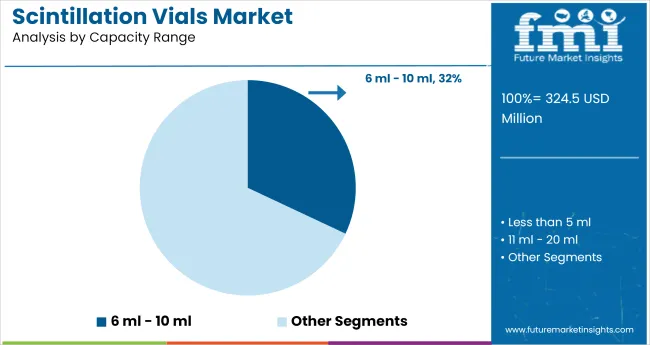
Scintillation vials with a capacity range of 6 ml to 10 ml are projected to contribute 32.0% of the total revenue share in 2025. This segment’s leadership is being supported by its suitability for standard volume scintillation protocols, especially in high-throughput laboratories conducting radiolabeling and isotope tracing studies. The 6 ml to 10 ml range provides an optimal balance between sample-to-cocktail ratio, enabling efficient counting while minimizing waste.
These vials are widely used in research settings requiring consistent sample handling, automated cap placement, and compatibility with universal counter racks. Their compact form allows for efficient storage and transport, making them highly preferred across academic, pharmaceutical, and environmental labs.
As precision diagnostics and molecular tracer usage expands, this segment is expected to maintain its strong presence due to standardization in test methods and regulatory consistency.
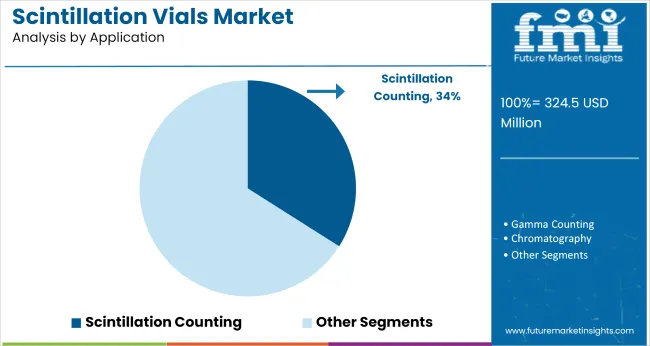
Scintillation counting is expected to lead with a 34.0% revenue share in the scintillation vials market in 2025. This application’s dominance is attributed to its widespread use in detecting and quantifying beta-emitting radionuclides across life science research, environmental monitoring, and nuclear medicine. Scintillation counting requires vials that ensure optical clarity, chemical inertness, and dimensional uniformity to produce accurate, reproducible results.
Laboratories rely on specialized vials to maintain low background noise and maximize signal resolution during measurement. The application has gained further traction with the development of high-sensitivity counters and miniaturized radioactive tracers, which necessitate vial formats that align with instrumentation parameters.
Regulatory requirements in radiation handling, combined with continued innovation in scintillation fluids, have reinforced demand for optimized containers. With ongoing advancements in isotope-based diagnostics and therapeutics, scintillation counting is expected to remain the primary driver of vial usage across key scientific domains.
Changing environmental conditions have led to an increase in health problems and diseases. Need for a safe and hygienic storage system is anticipated to drive the market for vials. The vials are growing on the backdrop of upsurge demand from several end use like biotech, life sciences, pathology, etc.
In addition, evolving pharmaceutical sector and growth in diagnostics related spending is projected to acts as a key driver for the development of these vials’ market during the forecast period.
Furthermore, increasing awareness about health concerns has led to increased check-up rates, which is driving the desired market. The desired vials can be reused and recycled, which provides an eco-friendly option and can gain attention of the consumers.
Plastic vials with caps are easy to carry and are even light weight and tough as compared to glass vials. However, government regulations for disposal of plastic waste can hamper the plastic scintillation vials market during the forecast period. Glass vials are vulnerable and can easily break thus can hinder the global vials market during the forecast period.
In the past, pharmaceutical and biotech companies dominated the vials market under the end user segment, and they will also witness the fastest growth in the usage of vials in the near future.
As these firms manufacture drugs in bulk, they require vials in large numbers. The rising demand for more-effective drugs, owing to the increasing prevalence of chronic and acute diseases, is propelling the procurement of such products by biopharma and pharma companies
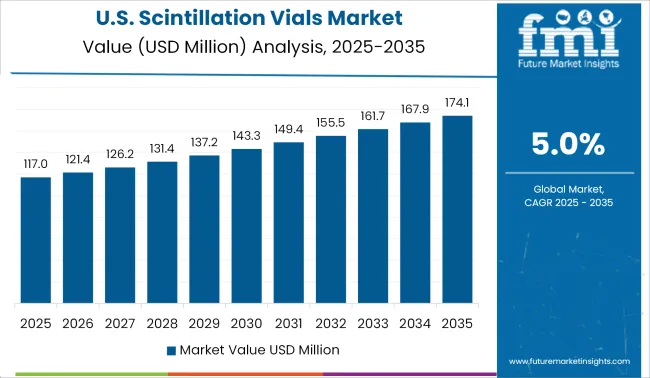
In North America, USA is anticipated to witness significant growth for the market of these vials during the forecast period. The USA is currently the most-lucrative vials market on account of the expansion of its pharmaceutical industry, presence of established industry players, rise in the awareness regarding the newly launched drugs, and high spending on research and development efforts.
In Asia Pacific region, India, China and South Asian countries are estimated to witness extensive growth for scintillation vials market share. Growing biopharma research in these countries is augmenting demand from the established pharmaceutical manufacturing sector in these countries.
Increasing research & development spending in these countries is projected to further drive the market of these vials during the forecast period.
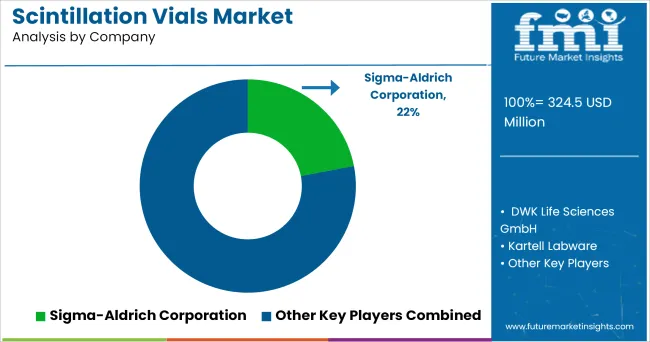
Some of the leading manufacturers and suppliers of Scintillation Vials include
As a result, extensive research and development (R&D) has unearthed numerous drugs, many of which have already received the regulatory approval and are now being used worldwide. Since most of these drugs are injectable, the pandemic has resulted in a demand surge for the vials market which is providing revenue generation opportunities for key vial makers.
The report is a compilation of first-hand information, qualitative and quantitative assessment by industry analysts, inputs from industry experts and industry participants across the value chain.
The report provides in-depth analysis of parent market trends, macro-economic indicators and governing factors along with market attractiveness as per segments. The report also maps the qualitative impact of various market factors on market segments and geographies.
The global scintillation vials market is estimated to be valued at USD 324.5 million in 2025.
The market size for the scintillation vials market is projected to reach USD 528.6 million by 2035.
The scintillation vials market is expected to grow at a 5.0% CAGR between 2025 and 2035.
The key product types in scintillation vials market are plastic, polyethylene (pe), high density polyethylene (hdpe), low density polyethylene (ldpe), polyethylene terephthalate (pet), polypropylene (pp) and glass.
In terms of capacity range, 6 ml - 10 ml segment to command 32.0% share in the scintillation vials market in 2025.






Full Research Suite comprises of:
Market outlook & trends analysis
Interviews & case studies
Strategic recommendations
Vendor profiles & capabilities analysis
5-year forecasts
8 regions and 60+ country-level data splits
Market segment data splits
12 months of continuous data updates
DELIVERED AS:
PDF EXCEL ONLINE
Assessing Scintillation Vials Market Share & Industry Trends
Micro Vials Market Size and Share Forecast Outlook 2025 to 2035
Serum Vials Market Size and Share Forecast Outlook 2025 to 2035
Shell Vials Market Size and Share Forecast Outlook 2025 to 2035
Plastic Vials and Ampoules Market Size and Share Forecast Outlook 2025 to 2035
Polymer Vials Market Insights & Industry Growth 2025 to 2035
Leading Providers & Market Share in Plastic Vials and Ampoules Industry
Flip Top Vials Market Size and Share Forecast Outlook 2025 to 2035
Formalin Vials Market Size and Share Forecast Outlook 2025 to 2035
Cosmetic Vials Market Trends - Size & Growth 2025 to 2035
Snap Cap Vials Market
Interlock Vials Market Size and Share Forecast Outlook 2025 to 2035
Cryogenic Vials and Tubes Market Size and Share Forecast Outlook 2025 to 2035
Market Share Distribution Among Interlock Vials Manufacturers
Diagnostic Vials Market Size and Share Forecast Outlook 2025 to 2035
Breaking Down Diagnostic Vials Market Share & Industry Insights
Speciality Vials Market
Autosampler Vials Market Size and Share Forecast Outlook 2025 to 2035
Push-in Plug Vials Market Size and Share Forecast Outlook 2025 to 2035
Pharmaceutical Vials Market Size and Share Forecast Outlook 2025 to 2035

Thank you!
You will receive an email from our Business Development Manager. Please be sure to check your SPAM/JUNK folder too.
Chat With
MaRIA